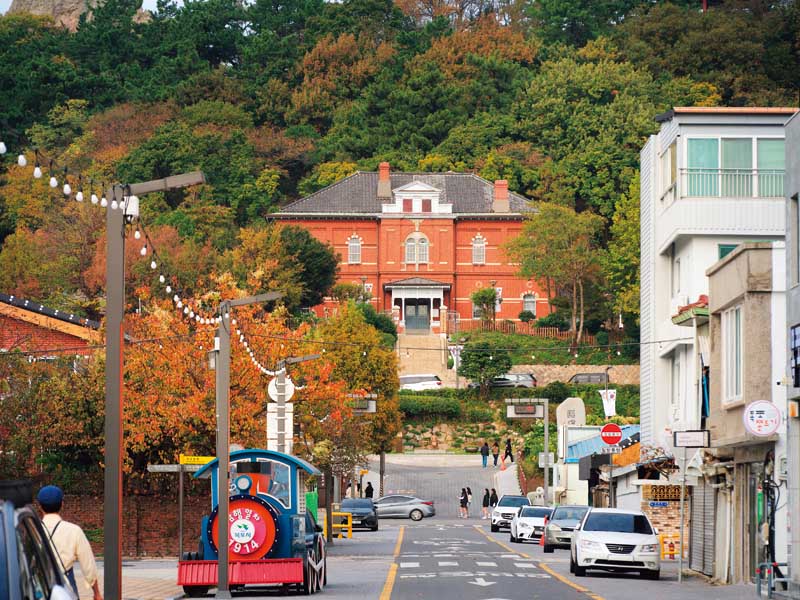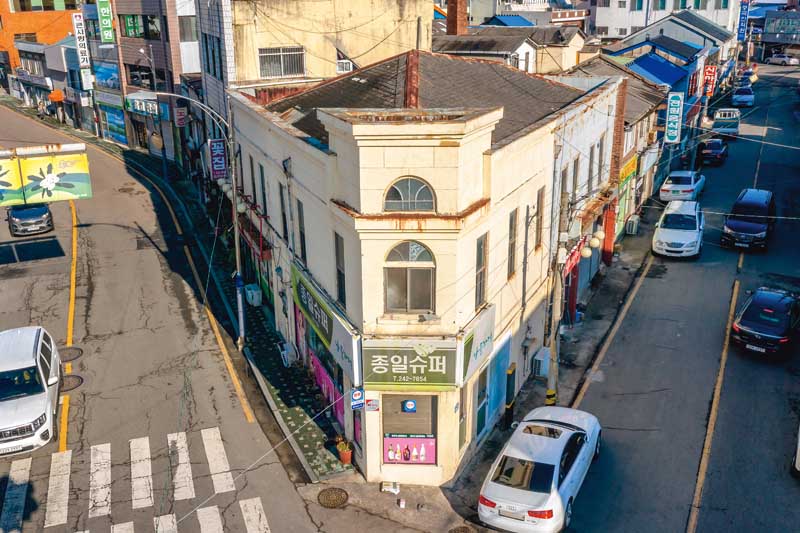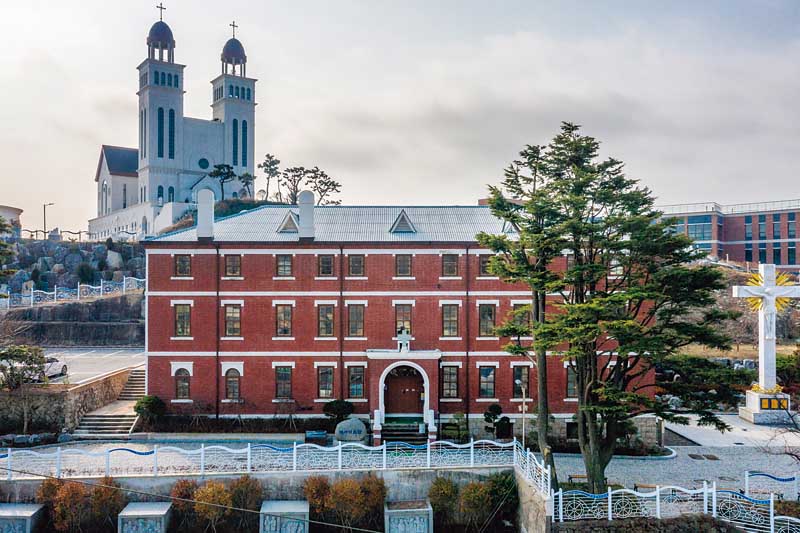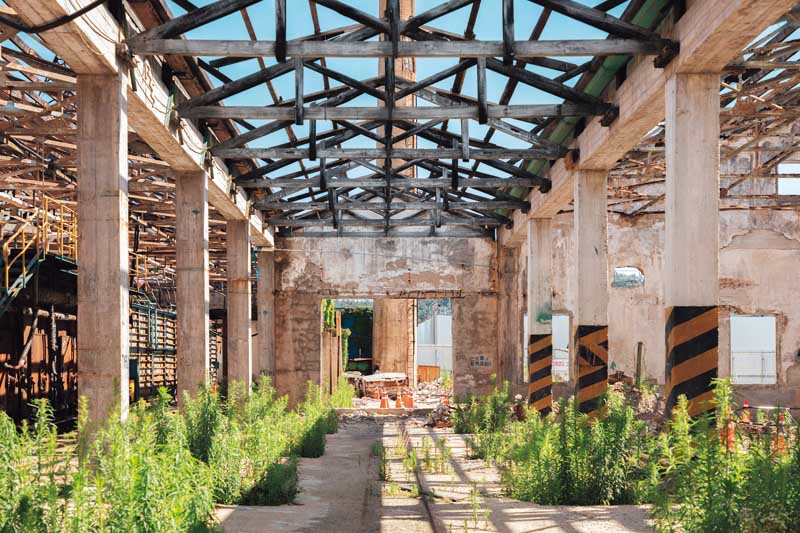Mokpo, gateway to the southwestern coast of the Korean peninsula, has long served as a strategic link between inland waterways and the sea. Its favorable location made it an important military stronghold in earlier centuries, and after the opening of its port in 1897, the city flourished as one of Korea’s four major ports and six largest cities. This legacy has made Mokpo widely known as the cradle of Korea’s modern culture.

Built in 1900 at the foot of Mt. Yudal, the former Japanese consulate is a red-brick, two-story Renaissance-style building. After serving as a library and cultural center, it reopened in 2014 as Hall One of the Mokpo Modern History Museum.
© Lee Min-hee
Situated where the Yeongsan River, one of Korea’s four major rivers, meets the sea, Mokpo enjoys the dual geographical advantage of river access to the inland and maritime connections to the many nearby islands. Its strategically favorable location prompted the establishment of a naval base in 1439 to guard the Joseon Dynasty (1392–1910) against foreign invasions. In 1897, Mokpo became Korea’s fourth port for international trade, and the first in the Jeolla Provinces. The city was selected for its ideal location for exporting rice and other specialties produced in the province’s fertile fields, as well as for its strong potential as a center of trade. Mokpo then opened its doors to foreign residents, developing into a place with cosmopolitan character where modern culture spread more rapidly than anywhere else in Jeolla.

At the Haean-ro Intersection stands a two-story wooden building, combining commercial and residential use, from downtown Mokpo’s modern era. Polygonal in design to fit its irregular lot, it draws the eye with its arched windows and rooftop ornamentation.
© The Academy of Korean Studies
SPREAD OF MODERN CIVILIZATION
After Mokpo became an open port, a new urban district took shape along the waterfront. The coast near Mokpojin, a former military post, was reclaimed to make way for roads and buildings. People from Japan, China, Russia, Britain, and other countries settled here, with Japanese residents forming the largest group. In 1900, Japan built a large consulate on a hill overlooking the port. The building still stands today, now housing the main hall of the Mokpo Modern History Museum. Around the same time, many Koreans moved to the growing port city and settled along the lower slopes of Mt. Yudal. The city’s districts were thus divided between Korean and Japanese neighborhoods.
The development of modern transportation further accelerated Mokpo’s urbanization. Mokpo Station opened in 1913, followed the next year by the completion of the Honam Line to Daejeon, which turned Mokpo into a hub of rail transport. As modern steamships linked Mokpo Port with the surrounding islands, maritime transport expanded as well. This close connection to the Dadohae archipelago encouraged active exchange and drew islanders to settle in the city, fueling Mokpo’s growth.
After 1897, Mokpo became the key entry point for modern civilization into South Jeolla Province, with new public facilities — schools, hospitals, churches, cathedrals, theaters, post offices, police stations, courts, and fire stations — built here first before spreading to other regions. Foreign missionaries also played an important role in Mokpo’s modernization. The city served as a base for both Protestant and Catholic missionaries, who went on to establish educational and medical institutions. American missionaries built a church in Yang-dong, on the Mokpo coast, and also opened the province’s first women’s school in 1903, while other foreign missionaries set up clinics that introduced Western medicine. The Catholic Church built a cathedral in Sanjeong-dong, near Mokpo Station, extending its influence in the region and on the city’s neighboring islands.
LIVING HISTORY MUSEUM
The many buildings erected during Mokpo’s growth period are now recognized as part of Korea’s modern cultural heritage. In 2018, the Korea Heritage Service designated the old port district as the Mokpo Modern History and Culture Space, a National Registered Cultural Heritage site. Here, early modern consulates, banks, schools, department stores, gardens, churches, and cathedrals line grid-pattern streets, offering a glimpse into the city’s past. A growing appreciation for this architectural heritage has brought a steady stream of visitors in recent years. The area has also served as a backdrop for movies and K-dramas and buzzes with activity during festivals celebrating the city’s history.
In addition to the old port district, many modern cultural heritage sites are preserved in Mokwon-dong at the foot of Mt. Yudal, where Koreans settled. This neighborhood includes Mokpo Station, Mokpo Youth Center, built in 1924 as the first civic hall funded by Korean donations, and Yangdong Church, completed in 1911 through the joint efforts of American missionaries and local residents. With so many historic sites clustered in a compact area, Mokpo is ideal for exploring modern cultural heritage on foot — earning it the nickname “a living museum of modern history.”
Mokpo is also known as “home of the arts” thanks to the many renowned artists it has produced and the cultural sophistication of its citizens. The city’s reputation as a center of the arts can be traced to the rapid influx of modern culture after the opening of the port. Exposure to Western influences arrived here ahead of many other cities, so Mokpo’s locals had significantly more opportunities to experience diverse forms of arts and culture. The establishment of an international maritime route connecting Mokpo and Japan also enabled many local artists to further their studies abroad. Today, Mokpo is home to six municipal art institutions, including the Mokpo Museum of Literature, Mokpo Hall of Popular Music, Mokpo Literary History Museum, and Nojeokbong Art Park & Museum — a testament to the city’s lively arts and culture scene.

Completed in 1897, Sanjeong-dong Cathedral was the first church of the Catholic Archdiocese of Gwangju and played a pivotal role in the spread of Catholicism in South Jeolla Province. Its martyrdom monument commemorates three priests who were killed during the Korean War.
© The Academy of Korean Studies
LEGACY MEETS THE SEA

The exposed truss of the former Chosun Refractories Mokpo plant stands open to the clear blue sky, revealing the building’s structural bones.
© Chosun Refractories
Mokpo was also the second home of Kim Dae-jung, the 15th president of Korea and the first Korean Nobel laureate. Born on Haui Island in Sinan County, Kim completed his schooling in Mokpo, from elementary to commercial high school. In 1963 and 1967, he was elected to the National Assembly as a representative for Mokpo, emerging as a leading figure in Korea’s democracy movement. In 1998, he was elected president, and in 2000 he was awarded the Nobel Peace Prize for his efforts to improve inter-Korean relations. Today, the Kim Dae-Jung Nobel Peace Prize Memorial in Mokpo’s Samhakdo Park welcomes visitors all year round.
In recent years, Mokpo has transformed into a vibrant tourist destination. Alongside its modern cultural heritage, the port city is emerging as a hub for marine tourism. The opening of the marine cable car between Mt. Yudal and Gohado in 2019 further boosted visitor numbers. An influx of people relocating from other regions, coupled with a diverse array of activities for young people, has added to the city’s vitality. Though modest in size, Mokpo serves as the heart of Korea’s southwest, embracing the Dadohae archipelago with its over one thousand islets. With its storied past and thriving cultural scene, Mokpo stands as a port city both enduring and alive.